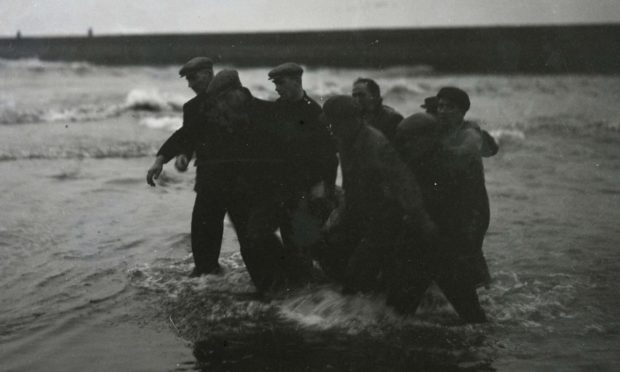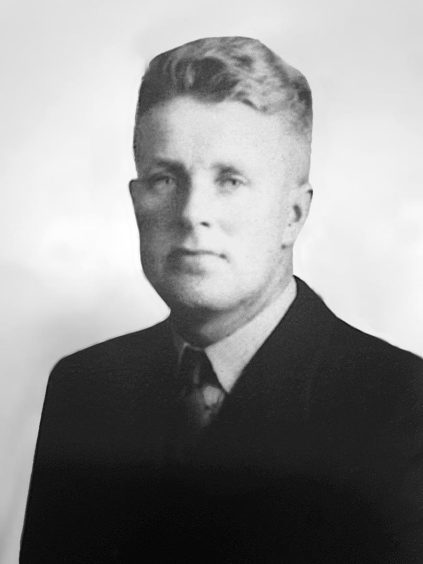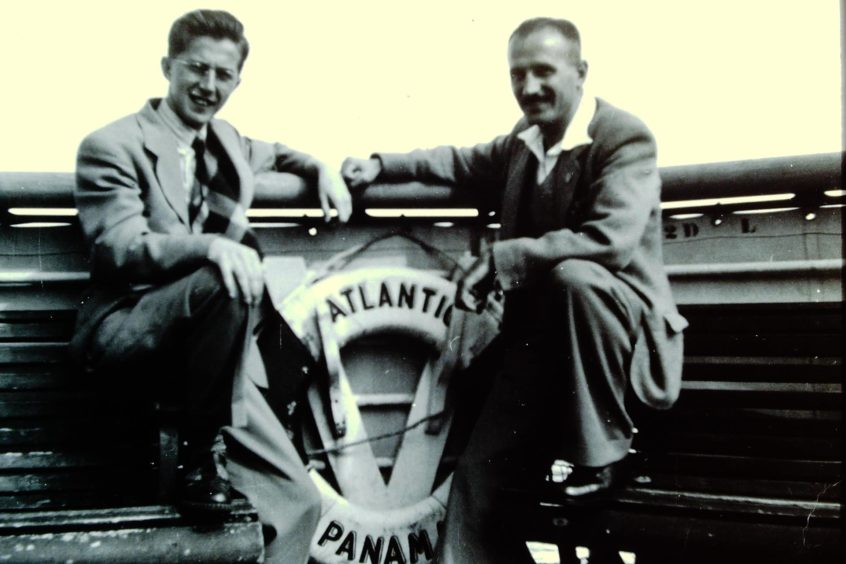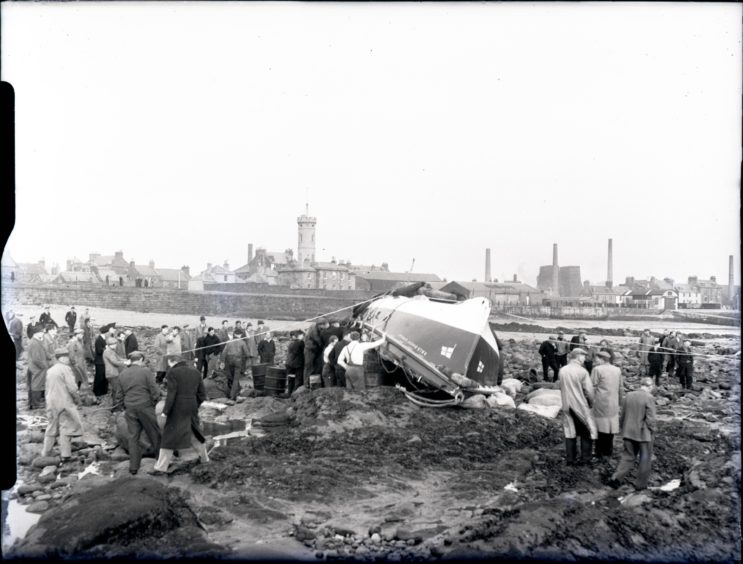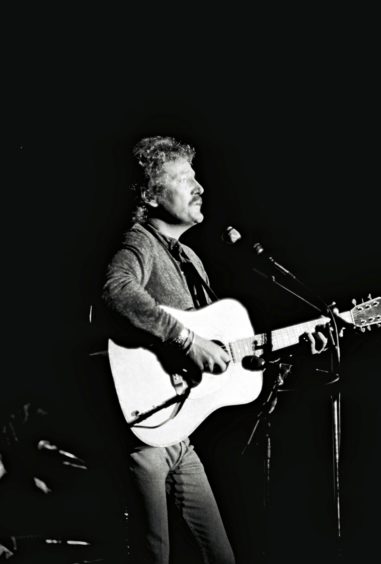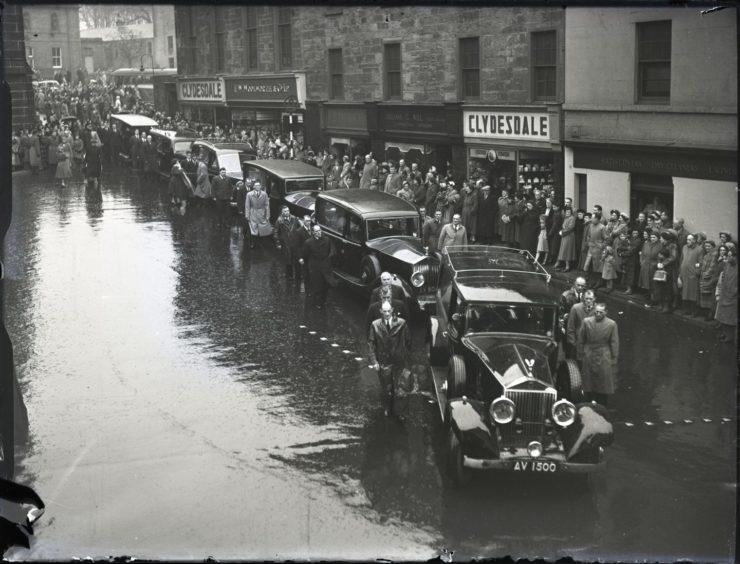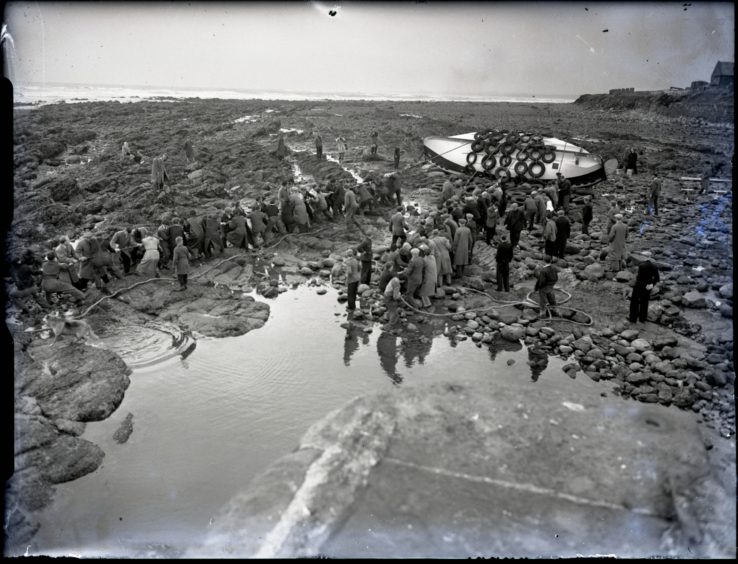A memorial call has been made to honour the ‘forgotten’ victims of a Tayside maritime disaster.
Steve Rendall’s grandfather James Rendall died when the Dundee sandboat Islandmagee sank with all hands on October 26/27 and the Arbroath lifeboat, which was dispatched to the scene after being alerted by rocket flares and calls of mayday on the radio, also went down into the dark abyss.
All but one of her crew perished as well.
A plaque in the lifeboat crew’s memory is displayed in the lifeboat shed.
Now Steve has called for the victims of the Islandmagee to be remembered in a similar fashion some 67 years after the ‘Sliding Doors’ moment which would result in his grandfather’s final journey to a watery grave.
Orkney Islands
Steve’s grandfather was born in Westray in the Orkney Islands in 1901.
He worked for a time on a farm in Aberdeenshire before going off to sea until the start of World War Two.
When he left the Merchant Navy he was employed as a scaffolder by Henry Robb Shipbuilders and later as a security guard in Leith with Shell Oil.
James, who was married to Jeannie with three grown-up children Gavin, Ted and Margaret, agreed to take his place in the crew of the ill-fated Islandmagee after 40-year-old sandboat seaman Christopher Howie broke his arm while playing football.
The coastal cargo class steamship, built in 1900 by Scott & Sons, had been carrying 200 tons of wet sand to the port of Leith.
She had made at least 150 voyages between Dundee and Leith with only a limited number of trips on other routes although she did manage a few to the North Sea ports of continental Europe.
She set sail from Birkhill around 5pm on October 26 1953 despite warnings of gale force winds on the BBC shipping forecast.
On board the ship was a crew of six.
The Islandmagee was last seen off Crail at around 9.15pm.
A storm gale came up that quickly turned into a force 9 storm, with strong winds and high waves.
The Islandmagee managed to fire off her distress rockets before going down like a stone with all hands, off the mouth of the Tay on passage to the Forth.
Steve’s father Ted received a telegram from his older brother Gavin with the cryptic message: ‘Father lost at sea – Gavin’.
“He had no money to make his way back to Scotland for the funeral and to be with his family, as he had spent every penny he had to emigrate to Canada to attend school,” said Steve, who lives in Three Hills, Alberta, Canada.
“In many ways he grieved alone.
“He was barely twenty years old.
“Of course I would love to have met my grandfather and learned more about him.
“A lot of folk say that our oldest son, Rob looks a lot like him.
“From the very little I know about my grandfather I have been told he was a quite a shy, reserved man.
“He was very artistic with one of his specialties being ships in bottles which he could craft.
“I think the fact that my grandfather’s body was never found would be much more difficult for his own children.
“I think a plaque would and could be very fitting.
“I would be more than happy to contribute to such a project.”
Distress flares
Passing the North Carr Light vessel the Islandmagee was noted as ‘making very heavy weather’.
Fife Ness coastguards then saw some red distress flares about three miles out to sea.
This led to the launching of the Arbroath and Anstruther lifeboats on a rescue mission that tragically failed to discover any trace of the Islandmagee.
The lifeboats returned reluctantly to their respective harbours, but then further disaster struck.
As it entered the harbour at Arbroath, the lifeboat capsized.
Lifeboat officials saw the Robert Lindsay approaching the gap between the breakwater and the harbour wall before the lights disappeared.
The Arbroath lifeboat was within sight of safety when it was overwhelmed by 20-foot waves.
Cries for help were heard and the coastguard fired rocket lines at random.
Only one man survived.
Archibald Smith, of Ladyloan, managed to grasp a rope shot from the shore.
The other six members of the crew all lost their lives.
They were David Bruce, Harry Swankie, Thomas Adams—Bowman, William Swankie, Charles Cargill and David Cargill.
They came from the town’s fishing community and hardly a family from it was left untouched by the tragedy.
The town awoke to find the lifeboat upside down on the rocks west of the breakwater.
While Arbroath was still deep in shock, it was only days later that three bodies were washed ashore in the Tay Estuary.
They were identified as members of the crew of the Islandmagee.
The wreck of the Islandmagee was positively identified by recovery of the ship’s maker’s plate and bell in 1986.
Traumatic memories
Steve, who lives with his wife Cathy and has three children and five grandchildren, is an award-winning music producer but there was one song which he was not allowed to play because it brought back traumatic memories for his father.
Steve said: “In November of 1976, I was 15-years-old.
“One particular day I was glued to my little AM radio, as I often was, surfing the airwaves for anything that would catch my ear.
“The haunting strains of an electric guitar, a steel guitar and an acoustic 12 string guitar soared across the airwaves.
“After the distinctive introduction, the iconic voice of Gordon Lightfoot began to sing: ‘The legend lives on from the Chippewa on down…’
“I was hooked!
“I had never heard anything that sounded remotely like this, and as the song unfolded I realised that it was a ‘story song’.
“It told the tragic tale of the bulk carrier called the SS Edmund Fitzgerald, which sank in Lake Superior while hauling iron ore from Duluth, Minnesota to Detroit, Michigan on November 10, 1975.
“Twenty-nine men lost their lives that night in an awful storm.
“When launched on June 7, 1958, the SS Edmund Fitzgerald was the largest ship on North America’s Great Lakes, and she remains the largest to have sunk there.
“While Lightfoot certainly took some artistic license in the telling of those events, he captured the essence of the horror in a very real way.
“As I often did when I made a new discovery or was excited about something, I went to find my dad.
“I told him that I had just discovered a new song on the radio that I thought he would like, and that I would play it for him the next time it came on.
“I knew dad loved ships and the sea and I thought this would be right up his alley.
“Always trying to support my endeavours, dad said that would be just fine and to let him know when the song played again.
“A couple of hours later the song came on, and I rushed upstairs from my little basement studio/shop to find dad sitting in his chair.
“He was probably studying or marking papers, his normal activity on any given evening in our home.
“Turning up the song, I looked at dad expectantly for his affirmation of what a truly great song this was, and what great taste I had!
“Dad began to look agitated, and even irritated, as the song played on.
“Now The Wreck of the Edmund Fitzgerald did not follow the typical pop formula of a three-minute song.
“It actually clocks in at six minutes and 40 seconds.
“As we sat in the living room for those long painful minutes, the atmosphere grew more and more awkward.
“Finally the song came to an end, and Dad said, in maybe the most serious tone of voice I had ever heard him speak: ‘Son, never play me that song again!’
“I was shocked and confused.
“Then, to my youthful, naive self, a little light went on.
“It finally computed, and I felt absolutely horrible.
“You see, on that fateful day of October 26, 1953, the Islandmagee took on water and sank, taking with her the entire crew – including my dad’s father, gone at the age of only 52.
“There was compelling evidence that at least some of the crew had made it into one of the lifeboats, but it sank as well.
“All the crew except my grandfather were washed up on the coast of Fife, still wearing their life jackets.
“The hypothesis is that my grandfather rushed to launch the lifeboat which would have been tied down on deck, as his leather knife holder was found later in the lifeboat, floating on the sea.
“He did not have time to put on a lifejacket.”
A court inquiry held in February of 1955 stated: “The Court is therefore of the opinion that the evidence does not disclose that the casualty to Islandmagee was caused, or contributed to, by the fault or default of any person or persons”.
The lifeboat’s lights suddenly disappeared
The fate of the Robert Lindsay was recounted in parliament by Minister of Transport and Civil Aviation Alan Lennox-Boyd, who declared: “At about 5.45am the lifeboat’s lights suddenly disappeared and shouts were heard from the water.
“The Arbroath coastguard and members of the Life Saving Company fired lines across the men in the water, and one member of the lifeboat’s crew was hauled ashore alive.
“The body of the coxswain was found lashed to the wheel of the overturned lifeboat, which was later washed ashore, and I understand that the bodies of the other five members of the crew have all been recovered.”
The loss of the Robert Lindsay had a profound impact on the Arbroath community, and the 60th anniversary was marked by a wreath-laying at sea.
A fatal accident inquiry before Sheriff MacKinnon and a jury in Dundee returned an open verdict on the six victims.
Sheriff MacKinnon gave his opinion that this most tragic affair was not to be put down to any human fault, but was solely due to an overwhelming combination of the elements – the storm and the sea, which could be, and in this particular instance certainly was, a cruel sea.
